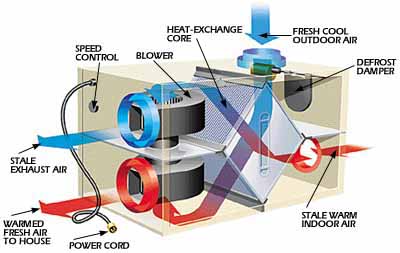heat recovery ventilator

Illustration by George Retseck. Published in the August 2000 issue of Popular Mechanics.
A heat recovery ventilator is a device that captures the heat from the exhaust air from a building and transfers it to the fresh air entering the building to preheat the air and increase overall heating efficiency. The need for heat recovery ventilators (HRVs) has grown as residential buildings, both old and new, have become more air tight in the push for increased energy efficiency. A building that doesn't allow heated or conditioned air to leak out still needs a source of fresh air to avoid a buildup of moisture and pollutants. It doesn't make sense to open a window for ventilation during cold weather, since this destroys the energy efficiency of the building. Hence, the need for an HRV.
How it works
A typical HRV uses two fans, one to expel household air and the other to bring fresh air in. The key feature of an HRV is its heat-exchange core, which transfers heat from the outgoing stream to the incoming stream in the same way that a car radiator transfers heat from the engine's coolant to the outside air. The heat-exchange core is usually made up of multiple plates of aluminum or plastic separated by narrow passages through which incoming and outgoing airstreams flow. As the streams move through, heat is transferred from the warm side of each passage to the cold, without the airstreams coming into direct contact.
Depending on the model, HRVs can recover up to 85% of the heat in the outgoing airstream, making them far more energy efficient than letting air in and out through windows. In addition, an HRV filters the incoming air to trap particulates such as pollen or dust.
Although an HRV can be effective in the summer months, when it takes heat from incoming fresh air and transfers it to stale, air-conditioned exhaust air, it's most important use is in colder climates during the winter. A potential problem is buildup of frost inside the exchange core if temperature falls below about 20° F. To avoid this, a damper closes off the incoming cold airstream and routes warm air through the core. After several minutes, a timer opens the fresh-air port and allows ventilation to continue.
A typical HRV for residential use might move as much as 200 cubic feet (5.7 cubic meters) per minute of air, but the fan speed can be set to suit the air quality in the home. For example, a slow to medium fan speed may be adequate for normal living, while a house full of guests might require the highest setting. Controls are available for intermittent and remote operation.
Cost
Costs vary depending on the type and complexity of the installation, as well as on the size and features of the HRV. For new construction, the cost is typically $2,000 to $2,500. Retrofits generally cost more due to the difficulty of running ductwork to the source points. Also your energy bill will go up slightly to pay for replacing the heat that isn't recovered.
HRV vs. ERV
HRVs are ideal for tight, moisture-prone homes because they replace the humid air with dry, fresh air. In climates with excessive outdoor humidity, however, an energy-recovery ventilator (ERV) is more suitable.
